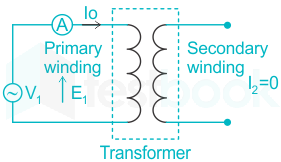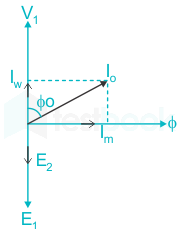B. 2 to 5 percent
C. 12 to 15 percent
D. 20 to 30 percent
Answer: B
Concept:
Operation of transformer on no load:

When the transformer is operating at no load, the secondary winding is open-circuited, which means there is no load on the secondary side of the transformer and, therefore, current in the secondary will be zero.
While primary winding carries a small current I0 called no-load current which is 2 to 10% of the rated current.
The no-load current consists of two components:
Reactive or magnetizing component (Im):
It is in quadrature with the applied voltage V1. It produces flux in the core and does not consume any power.
Active or power component (Iw): It is also known as a working component. It is in phase with the applied voltage V1. It supplies the iron losses and a small amount of primary copper loss.
Phasor diagram:

- The function of the magnetizing component is to produce the magnetizing flux, and thus, it will be in phase with the flux.
- Induced emf in the primary and the secondary winding lags the flux ϕ by 90 degrees.
- The primary copper loss is neglected, and secondary current losses are zero as I2 is zero.
- Therefore, the current I0 lags behind the voltage vector V1 by an angle ϕ0 called the no-load power factor angle and is shown in the phasor diagram.
- The applied voltage V1 is drawn equal and opposite to the induced emf E1 because the difference between them is negligible at no load.
- Active component Iw is drawn in phase with the applied voltage V1.
- The phasor sum of magnetizing current Im and the working current Iw gives the no-load current I0.
Conclusion:
The no-load current drawn by a transformer is usually 2 to 5 percent of the full-load current.
